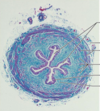Lecture 2 - Gross Anatomy (HARC 1) Flashcards
1
Q
Function of Kidney
A
1.) Excrete waste products of metabolism as urine 2.) Water and electrolyte balance in the body 3.) Maintain acid-base balance of blood
2
Q
What is the peritoneum?
A
A continuous transparent membrane which lines the abdominal cavity and covers the abdominal organs (or viscera).
3
Q
Where do the kidneys sit?
A
Lie behind peritoneum high on posterior abdominal wall either side of the vertebral column
4
Q
Why is the right kidney lower?
A
Liver
5
Q
Which ribs cover left kidney?
A
Ribs 11 and 12
6
Q
Which ribs cover right kidney?
A
Rib 12
7
Q

A

8
Q

A

9
Q
What is a renal calyx?
A
- Calyces are chambers of the kidney through which urine passes
- Minor calyces surround the apex of the renal pyramids.
- Two or three minor calyces converge to form a major calyx
10
Q

A

11
Q
Flow of Urine
A
Collecting Ducts → Minor Calyx → Major Calyx → Renal Pelvis → Ureter
12
Q

A

13
Q
Glomerulus
A
- Tuft of capillaries
- Blood enters via afferent arteriole
- Leaves via efferent arteriole
- Plasma filtrate passes over B’s C epithelium and enters proximal tubule.
- Controlled by juxtaglomerular cells (smooth muscle)
14
Q

A

15
Q
Kidney Blood Flow
A















